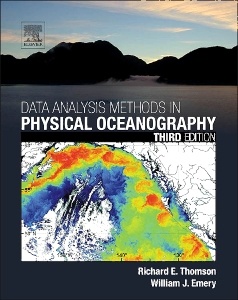Data Analysis Methods in Physical Oceanography (3rd Ed.) Second and Revised Edition
Auteurs : Thomson Richard E., Emery William J.

Data Analysis Methods in Physical Oceanography, Third Edition is a practical reference to established and modern data analysis techniques in earth and ocean sciences. Its five major sections address data acquisition and recording, data processing and presentation, statistical methods and error handling, analysis of spatial data fields, and time series analysis methods. The revised Third Edition updates the instrumentation used to collect and analyze physical oceanic data and adds new techniques including Kalman Filtering. Additionally, the sections covering spectral, wavelet, and harmonic analysis techniques are completely revised since these techniques have attracted significant attention over the past decade as more accurate and efficient data gathering and analysis methods.
1. Data Acquisition and Recording2. Data Processing and Presentation3. Statistical Methods and Error Handling4. The Spatial Analyses of Data Fields5. Time-series Analysis Methods6. Digital Filters
Appendix A: Units in physical oceanographyAppendix B: Glossary of statistical terminologyAppendix C: Means, variances and moment-generating functions for some common continuous variablesAppendix D: Statistical tablesAppendix E: Correlation coefficients at the 5% and 1% levels of significance for various degrees of freedom vAppendix F: Approximations and nondimensional numbers in physical oceanographyAppendix G: Convolution
William (Bill) Emery worked as a professor in Aerospace Engineering Sciences at the University of Colorado from 1987, prior to which he worked in the University of British Columbia where he created a Satellite Oceanography education/research program. He has authored over 220-refereed publications and 4 textbooks in addition to having given 200 conference papers. He is a fellow of: the IEEE (2002), the American Meteorological Society (2010), the American Astronautical Society (2011) and the American Geophysical Union (2012). He was recently elected to the IEEE TAB Hall of Honor (2020). In 2022 he received the GRSS Fawaz Ulaby Distinguised Achievement Award.
- Completely updated and revised to reflect new filtering techniques and major updating of the instrumentation used to collect and analyze data
- Co-authored by scientists from academe and industry, both of whom have more than 30 years of experience in oceanographic research and field work
- Significant revision of sections covering spectral, wavelet, and harmonic analysis techniques
- Examples address typical data analysis problems yet provide the reader with formulaic “recipes for working with their own data
- Significant expansion to 350 figures, illustrations, diagrams and photos
Date de parution : 07-2014
Ouvrage de 728 p.
19x23.3 cm
Thèmes de Data Analysis Methods in Physical Oceanography :
Mots-clés :
Aliasing; Argo floats; Band averaging; Bias; Bootstrap; Butterworth filters; CTD; Central limit theorem; Chemical tracers; Co- and quadrature spectra; Confidence intervals; Cosine filters; Covariance function; Cross-spectral analysis; Cyclostrophic EOFs; Digital filters (windows); Empirical orthogonal functions; Error propagation; Eulerian current velocity; Expected values; Extended EOFs; FFT; Fourier analysis; Fractals; Frequency-domain filters; Fundamental modes; Gauss-Markov smoothing/mapping; Gaussian statistics; Gibbs phenomenon; Global Drifter Program; Godin filters; Hamming filters; Hanning filters; Harmonic analysis; Horizontal maps; Hypothesis testing; Integral depth scale; Interpolation; Jack-knife; Kaiser-Bessel filters; Kriging; Lagrangian current velocity; Lanczos filters; Least squares; Least-squares spectral analysis; Map projections; Maximum likelihood; Objective analysis; Optimum interpolation; Principal component analysis; Probability density function; Property vs property plots; Random errors; Regime shift detection; Regression; SOFAR floats; Salinity; Sample size; Satellite altimetry; Sea level measurements; Sea surface temperature; Self-organizing maps; Semivariogram; Spectral analysis; Spectral filters; Spectral smoothing; Spectral windows; Spline interpolation; Statistical estimation; Surface drifters; TS curves; Tidal analysis; Tidal filters; Vector and scalar time series plots; Vector regression; Vertical sections; Wavelet analysis; Waves; XBT; temperature



